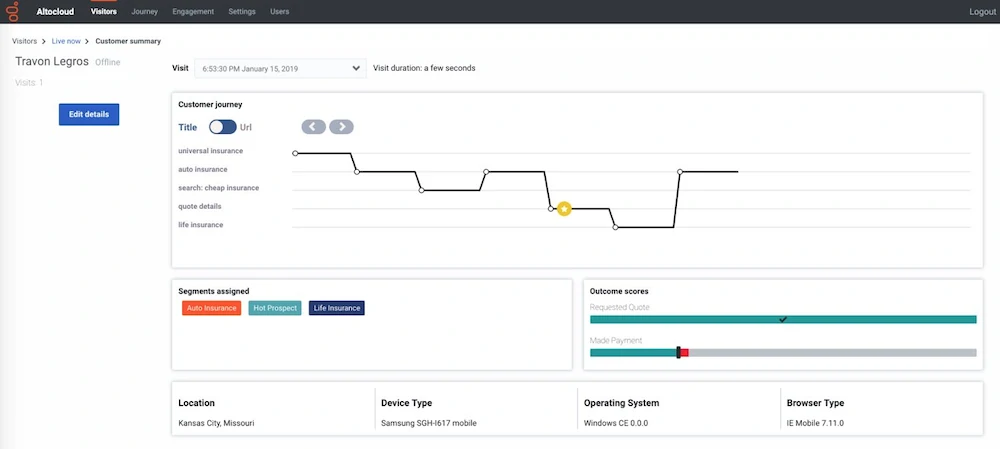
An endless number of online options are available to empower customers. Digital channels and easy access to information are at the forefront. As expectations evolve, it’s important to increase customer value and deliver great experiences.
Customers connect with your business via your website, self-service and mobile apps. And with each interaction, your job changes. You’ll re-visit systems and processes to support customers across these new touchpoints. And because customer experience is a top priority, digital disruption shifts business focus — moving it from traditional systems of record to dynamic systems of engagement. This means your business can orchestrate the customer journey in real time.
Put the customer at the centre of your business strategy. A journey-focused approach optimises the customer experience. And that drives loyalty and revenue. Taking an iterative, disciplined approach lets you assess and improve the customer journey as you go.
Look at journeys from your customers’ perspectives to understand what their experiences are like and how you can improve them.
A look at journey maps
A customer journey is a set of interactions a customer has with your business to complete a task. These can include evaluating, onboarding, getting support or purchasing a product or service. Buying journeys start long before users visit your website. And service and support experiences continue long after a purchase is made. Journey maps let you better understand customers — following buyers across channels and touchpoints.
Journey maps are data-driven and used to design customer-centric processes. In particular, they streamline the process of a multichannel customer engagement. Your first step is to create maps for a subset of journeys; focus on those that drive high transaction costs or high incremental customer value. These are a great starting point for designing personalised customer experiences. And these maps can serve as the foundation for programmes that optimise the entire customer journey.
“Genesys Predictive Engagement delivers more than chat. Their suite of digital engagement services comes at a reasonable, fixed cost and they offer deep customer journey analytics that let us see, understand and engage digital users in real time.” — Polycom
- Saved 72% in costs per chat in the first four months
- Saved 62% in costs per lead in the first four months
- Supported 10 languages
How Genesys orchestrates customer journeys
Successful journeys shape customer behaviour, reduce customer effort and improve efficiency. But to succeed and gain the understanding needed to deliver measurable results, you need to orchestrate, track and optimise these journeys.
You could have thousands of customers on your website at one time. These customers are reaching your business at many points and taking different journeys to the same goal. There’s no way to interact with every user across every channel. Yet, many will need help.
Genesys Predictive Engagement uses the power of artificial intelligence (AI) to know when a customer veers away from the path. It then determines whether to engage and how to help users get back on track through the next-best action. By stepping in to orchestrate the journey and guide the customer in real time, you streamline the experience at the moment that matters most.
Effective management of customer journeys requires an understanding of important touchpoints. Manage those touchpoints with AI-powered automation. It lets you predict how customers will engage all along the journey so you can offer help when it’s needed most.
Here’s how customer journey orchestration works.
See what’s happening with the customer
Capture cross-channel customer information. This is rich data that provides insights about how to tailor experiences. When you collect data from all customer touchpoints over time, you can create a full, accurate picture of each customer. Plus, you can track channel behaviour.
By aggregating information across many customers, you get population-level learning. This is ideal to improve products or services. And it’s an effective way to use data to stay relevant and ahead of the competition. Use historical data in Genesys AI to build prediction models and power engagement.
Send notifications at the right time
Optimise the customer journey by knowing when to send notifications or to otherwise engage. Detect the moment of confusion or indecision. And then address it early by triggering the most effective engagement action. Use bot notifications, content offers, a human agent or a combination of these methods. Keep customers on track by offering support when they need it.
Remember: Bots can handle many repetitive tasks. This gives agents more time for complex issues and one-on-one conversations.
Take action based on customer behaviour
With a 360-degree view of customers, your agents have a distinct advantage. When they engage, they know who the customer is and what has happened up to that moment in time. They have full context across departments and channels. Most importantly, they have real-time information about recent relevant activity and interactions.
Capturing this information in real time enables predictive engagement to understand customer behaviour. Then it recommends or takes the next-best action.

Predict customers’ next steps
Proactively engaging at the right moment drives more sales. Suppose a prospect is on your site trying to determine how fast an item will ship. Because they haven’t entered their address or delivery information, it’s unclear. But there’s a high-value item in their shopping cart. This scenario could trigger a chat with a bot. That moment of engagement is critical to reduce cart abandonment. If the customer has a more complex question, a human agent can intervene. And using data the bot or other systems have captured already means the agent can present special offers or discounts. Orchestrate this shift from bot to human agent to create personalised website experiences.
Move beyond random interactions
Journey mapping looks at customer interactions across all touchpoints. And it builds deeper relationships with each one. It places the customer at the centre of your business strategy. To do it properly, journeys must be orchestrated so that goals and desired outcomes are reachable. With a full view of customer behaviour across all channels they engage on, you can take action and guide them to resolution.
Customers have many opportunities to change vendors along their purchasing journeys. Get them to choose your business by combining the power of AI with predictive engagement. Engage users in a personalised way at the moment they need it. Then turn prospects into loyal customers.